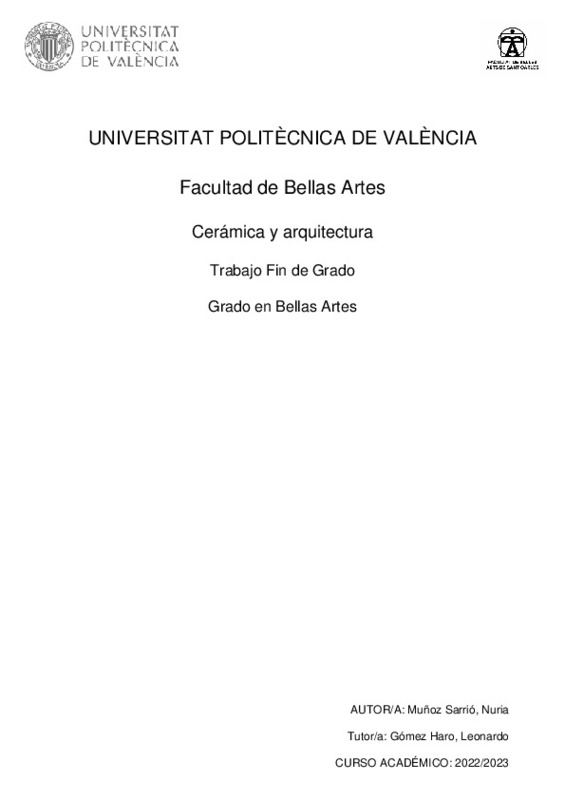JavaScript is disabled for your browser. Some features of this site may not work without it.
Buscar en RiuNet
Listar
Mi cuenta
Estadísticas
Ayuda RiuNet
Admin. UPV
Cerámica y arquitectura
Mostrar el registro sencillo del ítem
Ficheros en el ítem
| dc.contributor.advisor | Gómez Haro, Leonardo
|
es_ES |
| dc.contributor.author | Muñoz Sarrió, Nuria
|
es_ES |
| dc.date.accessioned | 2023-09-27T12:00:18Z | |
| dc.date.available | 2023-09-27T12:00:18Z | |
| dc.date.created | 2023-07-12 | |
| dc.date.issued | 2023-09-27 | es_ES |
| dc.identifier.uri | http://hdl.handle.net/10251/197212 | |
| dc.description.abstract | [ES] La cerámica y la arquitectura han estado interconectadas desde tiempos antiguos. La primera ha sido utilizada como un material de construcción idóneo para edificar viviendas y cabañas de adobe en la antigüedad, y para decorar edificios públicos, templos y palacios, en Mesopotamia, en la Antigua Grecia y en Roma. Así, además de ser utilizada como material de construcción, la cerámica también ha sido utilizada para decorar y embellecer los edificios. Se ha utilizado para hacer mosaicos, frisos y azulejos, y ha formado parte integral tanto de la arquitectura islámica y como la del Art Nouveau. Esto ha sido debido a que las características de los materiales cerámicos ofrecen numerosas ventajas para la arquitectura: durabilidad, resistencia al fuego y a la corrosión, capacidad para mantener la temperatura y la posibilidad de ser moldeada en una gran variedad de formas y colores. Con el fin de poner en valor la relación entre la cerámica y la arquitectura, en el siguiente Trabajo Final de Grado (TFG) se realiza, en una primera parte, más teórica, el estudio y documentación de las referentes que más nos han inspirado para realizar nuestro proyecto, siguiendo la evolución histórica de las conexiones señaladas. Para finalizar, una segunda parte práctica presentará un proyecto realizado para el presente TFG conformado por el diseño de una serie de módulos cerámicos inspirados en algunos de los ejemplos de arquitecturas cerámicas que nos han servido de referentes. | es_ES |
| dc.description.abstract | [EN] Ceramics and architecture have been interconnected since ancient times. Ceramics were used as an ideal building material for constructing houses and adobe huts in antiquity, as well as for decorating public buildings, temples, and palaces in Mesopotamia, Ancient Greece, and Rome. Thus, in addition to being used as a construction material, ceramics have also been utilized to adorn and beautify buildings. They have been used to create mosaics, friezes, and tiles, and have been an integral part of both Islamic and Art Nouveau architecture. This is because the characteristics of ceramic materials offer numerous advantages for architecture: durability, fire and corrosion resistance, the ability to maintain temperature, and the possibility of being molded into a wide variety of shapes and colors. In order to highlight the relationship between ceramics and architecture, this following Final Degree Project (TFG) begins with a theoretical section that focuses on studying and documenting the most inspiring references that have influenced our project, tracing the historical evolution of the aforementioned connections. Finally, a practical second section will present a project specifically developed for this TFG, consisting of the design of a series of ceramic modules inspired by some of the examples of ceramic architecture that have served as references for our work. | es_ES |
| dc.format.extent | 64 | es_ES |
| dc.language | Español | es_ES |
| dc.publisher | Universitat Politècnica de València | es_ES |
| dc.rights | Reserva de todos los derechos | es_ES |
| dc.subject | Cerámica | es_ES |
| dc.subject | Arquitectura | es_ES |
| dc.subject | Módulos | es_ES |
| dc.subject | Construcciones | es_ES |
| dc.subject | Ceramics | es_ES |
| dc.subject | Architecture | es_ES |
| dc.subject | Modules | es_ES |
| dc.subject | Constructions | es_ES |
| dc.subject.classification | ESCULTURA | es_ES |
| dc.subject.other | Grado en Bellas Artes-Grau en Belles arts | es_ES |
| dc.title | Cerámica y arquitectura | es_ES |
| dc.title.alternative | ceramics and architecture | es_ES |
| dc.title.alternative | ceràmica i arquitectura | es_ES |
| dc.type | Proyecto/Trabajo fin de carrera/grado | es_ES |
| dc.rights.accessRights | Abierto | es_ES |
| dc.contributor.affiliation | Universitat Politècnica de València. Departamento de Escultura - Departament d'Escultura | es_ES |
| dc.contributor.affiliation | Universitat Politècnica de València. Facultad de Bellas Artes - Facultat de Belles Arts | es_ES |
| dc.description.bibliographicCitation | Muñoz Sarrió, N. (2023). Cerámica y arquitectura. Universitat Politècnica de València. http://hdl.handle.net/10251/197212 | es_ES |
| dc.description.accrualMethod | TFGM | es_ES |
| dc.relation.pasarela | TFGM\152708 | es_ES |
Este ítem aparece en la(s) siguiente(s) colección(ones)
-
BBAA - Trabajos académicos [5086]
Facultad de Bellas Artes






